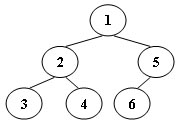二叉树基本操作
Suppose that all the keys in a binary tree are distinct positive integers. Given the postorder and inorder traversal sequences, you are supposed to output the level order traversal sequence of the corresponding binary tree.
Input Specification:
Each input file contains one test case. For each case, the first line gives a positive integer N (≤), the total number of nodes in the binary tree. The second line gives the postorder sequence and the third line gives the inorder sequence. All the numbers in a line are separated by a space.
Output Specification:
For each test case, print in one line the level order traversal sequence of the corresponding binary tree. All the numbers in a line must be separated by exactly one space, and there must be no extra space at the end of the line.
Sample Input:
7
2 3 1 5 7 6 4
1 2 3 4 5 6 7
Sample Output:
4 1 6 3 5 7
#include <cstdio> #include <queue> using namespace std; int post[50],in[50]; int n,s=0; //定义二叉树的基本操作 struct node//结点结构 { int value; node* left; node* right; }; node* rebuild(int pof,int pol,int inf,int inl) { if(pol<pof) return NULL; node* root=new node; root->value=post[pol]; int i=0; for(i=inf;i<=inl;i++) { if(in[i]==post[pol]) break; } int leftnum=i-inf; root->left=rebuild(pof,pof+leftnum-1,inf,inf+leftnum-1); root->right=rebuild(pof+leftnum,pol-1,inf+leftnum+1,inl); return root; } void level(node* root) { queue<node*> q; q.push(root); while(!q.empty()) { node* now=q.front(); q.pop(); printf("%d",now->value); s++; if(now->left!=NULL) q.push(now->left); if(now->right!=NULL) q.push(now->right); if(s<n) printf(" "); } } int main() { scanf("%d",&n); for(int i=0;i<n;i++) scanf("%d",&post[i]); for(int i=0;i<n;i++) scanf("%d",&in[i]); node* root=rebuild(0,n-1,0,n-1); level(root); return 0; }
按书上的套路多练练,熟悉常规操作。
An inorder binary tree traversal can be implemented in a non-recursive way with a stack. For example, suppose that when a 6-node binary tree (with the keys numbered from 1 to 6) is traversed, the stack operations are: push(1); push(2); push(3); pop(); pop(); push(4); pop(); pop(); push(5); push(6); pop(); pop(). Then a unique binary tree (shown in Figure 1) can be generated from this sequence of operations. Your task is to give the postorder traversal sequence of this tree.

Figure 1
Input Specification:
Each input file contains one test case. For each case, the first line contains a positive integer N (≤) which is the total number of nodes in a tree (and hence the nodes are numbered from 1 to N). Then 2 lines follow, each describes a stack operation in the format: "Push X" where X is the index of the node being pushed onto the stack; or "Pop" meaning to pop one node from the stack.
Output Specification:
For each test case, print the postorder traversal sequence of the corresponding tree in one line. A solution is guaranteed to exist. All the numbers must be separated by exactly one space, and there must be no extra space at the end of the line.
Sample Input:
6
Push 1
Push 2
Push 3
Pop
Pop
Push 4
Pop
Pop
Push 5
Push 6
Pop
Pop
Sample Output:
3 4 2 6 5 1
#include <cstdio> #include <stack> using namespace std; int post[50],in[50],pre[50]; int n; stack<int> temp; void build(int prel,int prer,int inl,int inr,int postl,int postr) { if(prel>prer) return; post[postr]=pre[prel]; int i; for(i=inl;i<=inr;i++) { if(in[i]==pre[prel]) break; } int len=i-inl; build(prel+1,prel+len,inl,i,postl,postl+len-1); build(prel+len+1,prer,i+1,inr,postl+len,postr-1); return; } int main() { char str[10]; int x,j=0,k=0; scanf("%d",&n); for(int i=0;i<2*n;i++) { scanf("%s",&str); if(str[1]=='u') { scanf("%d",&x); pre[j++]=x;temp.push(x); }else { in[k++]=temp.top(); temp.pop(); } } build(0,n-1,0,n-1,0,n-1); for(int i=0;i<n;i++) { printf("%d",post[i]); if(i<n-1) printf(" "); } return 0; }
The following is from Max Howell @twitter:
Google: 90% of our engineers use the software you wrote (Homebrew), but you can't invert a binary tree on a whiteboard so fuck off.
Now it's your turn to prove that YOU CAN invert a binary tree!
Input Specification:
Each input file contains one test case. For each case, the first line gives a positive integer N (≤) which is the total number of nodes in the tree -- and hence the nodes are numbered from 0 to N−1. Then N lines follow, each corresponds to a node from 0 to N−1, and gives the indices of the left and right children of the node. If the child does not exist, a - will be put at the position. Any pair of children are separated by a space.
Output Specification:
For each test case, print in the first line the level-order, and then in the second line the in-order traversal sequences of the inverted tree. There must be exactly one space between any adjacent numbers, and no extra space at the end of the line.
Sample Input:
8
1 -
- -
0 -
2 7
- -
- -
5 -
4 6
Sample Output:
3 7 2 6 4 0 5 1 6 5 7 4 3 2 0 1
#include <cstdio> #include <queue> using namespace std; int n; int k=0; int j=0; struct node { int left; int right; }nodes[15]; void invert(int root) { if(root==-1) return; invert(nodes[root].left); invert(nodes[root].right); swap(nodes[root].left,nodes[root].right); return; } void lev(int root) { queue<int> q; q.push(root); while(!q.empty()) { int now=q.front(); q.pop(); printf("%d",now); j++; if(j<n) printf(" "); if(nodes[now].left!=-1) q.push(nodes[now].left); if(nodes[now].right!=-1) q.push(nodes[now].right); } } void in(int root) { if(root==-1) return; in(nodes[root].left); printf("%d",root); k++; if(k<n) printf(" "); in(nodes[root].right); return; } int main() { char l,r; scanf("%d",&n); for(int i=0;i<n;i++) { scanf("%*c%c %c",&l,&r); if(l!='-') nodes[i].left=l-'0';else nodes[i].left=-1; if(r!='-') nodes[i].right=r-'0';else nodes[i].right=-1; } int judge[15]={0}; for(int i=0;i<n;i++) { if(nodes[i].left!=-1) judge[nodes[i].left]=1; if(nodes[i].right!=-1) judge[nodes[i].right]=1; } int root; for(root=0;root<n;root++) { if(judge[root]!=1) break; } invert(root); lev(root); printf("\n"); in(root); return 0; }
这一题用静态二叉树实现,没看仔细题,还要先反转(大概是我不认识那个单词所以直接忽略了),即便如此看了书后发现还用了一些技巧我没有想到。
输入时没注意而段错误,还有用后序遍历实现反转。